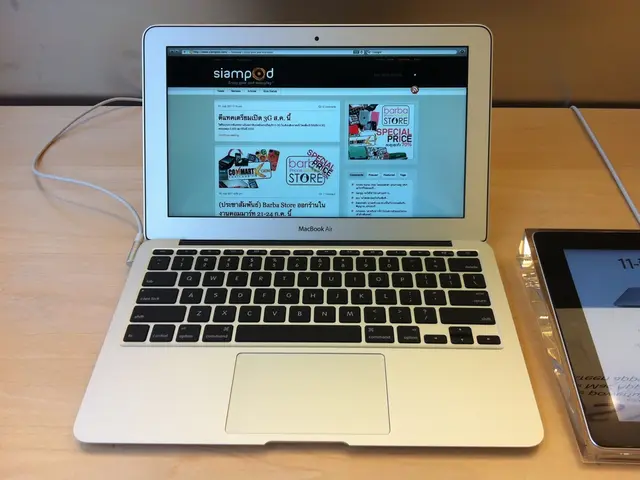Bitcoin's DeFi sector experiences accelerated growth with rootstock technology, predicted to reduce transaction fees by 60% by 2025, as per Messari's analysis
Rootstock, a sidechain that runs parallel to Bitcoin, is driving a transformation in the landscape of decentralized finance (DeFi) on the Bitcoin network. The platform achieved significant milestones during the first quarter of 2025, including a 60% reduction in transaction fees and the integration of the LayerZero protocol.
One of the key features of Rootstock is its use of merged mining with Bitcoin. This innovative approach allows miners to validate blocks simultaneously on both the Bitcoin and Rootstock networks, optimizing resources and earning rewards on both chains. Over 50% of Bitcoin's hash power is engaged in merged mining RSK, securing its network by leveraging Bitcoin's dominant, highly decentralized proof-of-work (PoW) hashrate.
Strengthened Network Security and Economic Incentives
This merged mining integration results in several benefits for Rootstock. Network security is significantly improved as Rootstock benefits from Bitcoin’s immense security, reducing susceptibility to 51% attacks. Miners earn dual rewards from both Bitcoin block subsidies and about 80% of Rootstock’s transaction fees per block, incentivizing robust participation and high decentralization.
Transaction fees from Rootstock are awarded to merged miners alongside Bitcoin rewards, helping maintain economic incentives without imposing extra mining costs. Fee levels are manageable due to scalability options like adjustable gas limits and proposals to increase throughput, such as RSKIP-144 for parallel transactions.
Integration into the DeFi Ecosystem
Rootstock offers a rich DeFi ecosystem on the Bitcoin network by providing Ethereum Virtual Machine (EVM) compatibility. Developers can deploy Solidity smart contracts unchanged from Ethereum, using familiar tools like MetaMask and Hardhat. This compatibility supports a wide range of DeFi applications on Rootstock.
Rootstock also employs a trust-minimized bridge mechanism called PowPeg, secured by tamper-proof Hardware Security Modules (PowHSMs), enabling BTC transfers in and out of its sidechain. This allows BTC holders to access DeFi dApps with native Bitcoin-backed assets on Rootstock without compromising security.
Ecosystem developer support is another crucial aspect of Rootstock's DeFi growth. Tools, starter kits, and tutorials enable rapid dApp development and integration of identity and validation systems, expanding DeFi potential on Rootstock.
The Lovell 7.0.0 Update
The Lovell 7.0.0 update, launched in March, focuses on security, scalability, and increased compatibility with the Ethereum Virtual Machine (EVM). The update includes EVM code optimizations to speed up the execution of smart contracts and reduce gas costs. An instant synchronization mode for nodes has been implemented, accelerating their startup and improving operational experience. A robust protocol for secure multi-signature validation in Rootstock's PowPeg bridge has been implemented, strengthening the network's security and decentralization.
Growing Adoption and Stablecoin Market
Active addresses on Rootstock show a slight decrease, but daily transactions continue to increase, reflecting constant and growing use of the Rootstock ecosystem. The growth in the stablecoin market strengthens the Rootstock network's resilience and offers users variety to choose from based on their security, liquidity, and financial productivity needs. The stablecoin market on Rootstock shows clear diversification, with USDT remaining the leader but alternatives like DOC and DLLR gaining ground.
Rootstock has integrated the LayerZero protocol to expand its capabilities and facilitate interaction between different blockchains, including Ethereum and Binance Smart Chain. This integration enables secure, fast, and efficient transfer of assets and data between Rootstock and over a hundred blockchains.
In conclusion, Rootstock's merged mining with Bitcoin and integration into major mining pools provide a strong security backbone and economic incentives without adding mining overhead. This, combined with Ethereum compatibility and interoperable bridges, supports growing transaction throughput, affordable fees, and increasing adoption in the DeFi ecosystem as of August 2025.
[1] Rootstock Official Website: https://rsk.co/ [2] Rootstock Developer Documentation: https://developers.rsk.co/ [3] Rootstock GitHub: https://github.com/rsksmart/rskj/releases/tag/v1.0.0-rc1 [5] Bitcoin Magazine: https://bitcoinmagazine.com/business/rootstock-achieves-60-reduction-in-transaction-fees-amid-growing-decentralized-finance-adoption
In the robust DeFi ecosystem provided by Rootstock on the Bitcoin network, safety and economic incentives are intricately linked. Miners earn dual rewards from both Bitcoin block subsidies and about 80% of Rootstock’s transaction fees per block, providing incentives for robust participation and high decentralization, thus enhancing network security (safety, finance, investing). Additionally, the integration of the LayerZero protocol enables secure, fast, and efficient transfer of assets and data between Rootstock and over a hundred blockchains, fostering technological advancements and facilitating interaction between different blockchains (technology).







